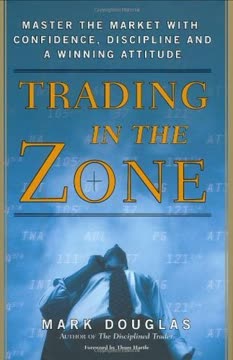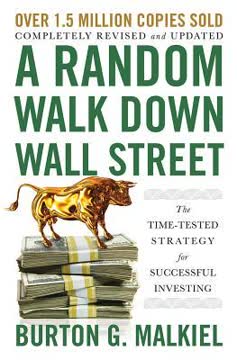Key Takeaways
1. The Stock Market: A Dynamic Arena of Fortunes Won and Lost
"From the opening bell at 9:30 A.M. Eastern Standard Time to the market's close at 4:00 P.M. , the U.S. stock markets never stop moving."
The stock market is a complex ecosystem where billions of dollars change hands daily, driven by a myriad of factors including economic indicators, company performance, and investor sentiment. It's comprised of various exchanges, with the New York Stock Exchange (NYSE) and NASDAQ being the most prominent in the United States.
Key components of the stock market include:
- Primary Market: Where new stocks are first issued (IPOs)
- Secondary Market: Where existing stocks are traded among investors
- Market Participants: Individual investors, institutional investors, and market makers
- Regulatory Bodies: SEC (Securities and Exchange Commission) and FINRA (Financial Industry Regulatory Authority)
Historical perspective: The U.S. stock market has its roots in the late 18th century, with the founding of the NYSE in 1792. Over the centuries, it has weathered numerous booms and busts, including the Great Depression, the Dot-com bubble, and the 2008 financial crisis, each time emerging more resilient and sophisticated.
2. Bull and Bear Markets: Understanding Market Cycles and Investor Sentiment
"Whether the market is characterized as 'bull' or 'bear' depends mainly on the prevailing direction of stock prices, but that is not the only factor in play."
Bull markets are characterized by optimism, investor confidence, and rising stock prices. They typically occur during periods of economic growth and low unemployment. Key features include:
- Sustained increase in stock prices (usually 20% or more)
- High trading volume
- Increased IPO activity
Bear markets, conversely, are marked by pessimism, falling stock prices, and economic contraction. They are often triggered by:
- Economic recessions
- Geopolitical crises
- Market bubbles bursting
Understanding market cycles is crucial for investors. These cycles are influenced by various factors including:
- Economic indicators (GDP, employment rates, inflation)
- Monetary policy (interest rates, quantitative easing)
- Investor psychology (fear, greed, herd mentality)
Recognizing the current market phase can help investors make more informed decisions about when to buy, sell, or hold their investments.
3. Market Crashes and Bubbles: Lessons from Historical Financial Catastrophes
"When a bubble bursts, it sometimes snowballs into a full market crash."
Market bubbles occur when asset prices are driven to unsustainable levels by irrational exuberance and speculation. They are characterized by:
- Rapid price increases disconnected from fundamental values
- Widespread belief that "this time it's different"
- High levels of leverage and risk-taking
Notable examples include:
- The Tulip Mania (1630s)
- The Dot-com Bubble (late 1990s)
- The Housing Bubble (mid-2000s)
Market crashes are sudden, severe declines in stock prices, often triggered by the bursting of a bubble or external shocks. Famous crashes include:
- The Wall Street Crash of 1929
- Black Monday (1987)
- The Financial Crisis of 2008
Lessons from historical crashes:
- Diversification is crucial for risk management
- Beware of excessive leverage and speculation
- Fundamentals matter in the long run
- Market sentiment can deviate from reality for extended periods
Understanding the dynamics of bubbles and crashes can help investors protect their portfolios and potentially capitalize on market dislocations.
4. Types of Stocks: Navigating the Diverse Landscape of Equity Investments
"Not all shares of stock are created equal."
The stock market offers a wide variety of equity investments, each with its own characteristics and risk-reward profile. Understanding these categories can help investors build diversified portfolios aligned with their goals.
Major stock categories include:
-
By Market Capitalization:
- Large-cap: Established companies, lower risk
- Mid-cap: Growing companies, moderate risk
- Small-cap: Younger companies, higher risk/potential
-
By Investment Style:
- Growth stocks: Focus on capital appreciation
- Value stocks: Undervalued companies with potential
- Income stocks: Emphasis on dividend payments
-
By Sector:
- Technology
- Healthcare
- Finance
- Consumer goods
- Energy
- And more...
-
Special Categories:
- Blue-chip stocks: Large, stable companies
- Penny stocks: Low-priced, highly speculative
- IPOs: Newly public companies
Each type of stock comes with its own set of risks and potential rewards. Investors should consider their financial goals, risk tolerance, and investment horizon when selecting stocks for their portfolio.
5. Fundamental Analysis: Key Metrics for Evaluating Stocks
"Earnings are the whole point of business, and every company aims to improve its bottom line."
Fundamental analysis is the process of evaluating a company's financial health and business prospects to determine its intrinsic value. Key metrics and tools include:
-
Financial Statements:
- Income Statement: Revenues, expenses, profits
- Balance Sheet: Assets, liabilities, equity
- Cash Flow Statement: Cash inflows and outflows
-
Valuation Ratios:
- Price-to-Earnings (P/E) Ratio: Stock price relative to earnings
- Price-to-Book (P/B) Ratio: Stock price relative to book value
- Dividend Yield: Annual dividends relative to stock price
-
Profitability Metrics:
- Return on Equity (ROE): Profit generated from shareholder equity
- Profit Margin: Profit as a percentage of revenue
-
Growth Metrics:
- Earnings growth rate
- Revenue growth rate
Analyzing these metrics allows investors to:
- Compare companies within an industry
- Assess a company's financial health and growth prospects
- Determine if a stock is overvalued or undervalued
However, it's important to remember that fundamental analysis should be complemented with other forms of research, including industry analysis and consideration of macroeconomic factors.
6. Investment Strategies: From Value Investing to Growth Investing
"Warren Buffett believes that if you buy stock in quality companies, you have no reason to sell your investments unless there is a serious underlying problem behind a price dip."
Different investment strategies cater to various investor goals, risk tolerances, and market outlooks. Some popular approaches include:
-
Value Investing:
- Seek undervalued stocks trading below intrinsic value
- Focus on fundamentals and long-term potential
- Exemplified by Warren Buffett and Benjamin Graham
-
Growth Investing:
- Target companies with high growth potential
- Willing to pay premium prices for future earnings
- Often associated with technology and emerging sectors
-
Income Investing:
- Prioritize stocks with regular dividend payments
- Focus on stable, mature companies
- Suitable for investors seeking steady cash flow
-
Momentum Investing:
- Ride trends in stock price movements
- Buy stocks showing upward momentum, sell those losing steam
- Requires active management and market timing
-
Contrarian Investing:
- Go against prevailing market sentiment
- Buy when others are selling, sell when others are buying
- Requires strong conviction and patience
Each strategy has its pros and cons, and many successful investors combine elements from different approaches. The key is to find a strategy that aligns with your financial goals, risk tolerance, and personal temperament.
7. The Psychology of Investing: Overcoming Emotional Pitfalls
"It turns out that many individual investors often act irrationally when it comes to making their buy and sell decisions."
Behavioral finance studies how psychological factors influence investor decisions and market outcomes. Common emotional pitfalls include:
-
Loss Aversion:
- Tendency to feel losses more strongly than equivalent gains
- Can lead to holding losing stocks too long or selling winners too early
-
Herd Mentality:
- Following the crowd rather than independent analysis
- Often leads to buying high and selling low
-
Confirmation Bias:
- Seeking information that confirms existing beliefs
- Can result in overlooking important contrary evidence
-
Overconfidence:
- Overestimating one's ability to predict market movements
- May lead to excessive trading and poor risk management
-
Recency Bias:
- Giving too much weight to recent events
- Can cause overreaction to short-term market fluctuations
Strategies to overcome these biases:
- Develop a disciplined investment plan and stick to it
- Practice diversification to manage risk
- Keep a long-term perspective
- Regularly review and rebalance your portfolio
- Consider seeking professional advice or using automated investing tools
Understanding and managing these psychological factors can significantly improve investment outcomes and help investors stay the course during market turbulence.
8. Famous Investors and Their Strategies: Learning from Wall Street Legends
"Though today we think of J.P. Morgan as an investment bank, John Pierpont Morgan was one of the most famous tycoons ever to trade on Wall Street."
Studying successful investors can provide valuable insights and inspiration. Some notable figures include:
-
Warren Buffett:
- Value investing approach
- Long-term perspective
- Focus on companies with strong competitive advantages
-
Benjamin Graham:
- Father of value investing
- Emphasized margin of safety
- Influenced many successful investors, including Buffett
-
Peter Lynch:
- "Invest in what you know" philosophy
- Growth at a reasonable price (GARP) strategy
- Achieved remarkable returns at Fidelity Magellan Fund
-
George Soros:
- Known for currency speculation and macro investing
- Theory of reflexivity in financial markets
- Famous for "breaking the Bank of England" in 1992
-
John Templeton:
- Global investing pioneer
- Contrarian approach
- Focus on fundamental analysis and value
Key lessons from these investors:
- Develop a clear investment philosophy
- Stay disciplined and patient
- Continuously learn and adapt
- Think independently and be willing to go against the crowd
- Manage risk through diversification and thorough research
While it's important to learn from these legends, investors should also recognize that market conditions change and strategies that worked in the past may not be as effective in the future. The key is to understand the underlying principles and adapt them to current market realities.
Last updated:
FAQ
What's "Stock Market 101" about?
- Comprehensive Guide: "Stock Market 101" by Michele Cagan is a comprehensive guide that covers the fundamentals of the stock market, including its history, key concepts, and major players.
- Understanding Markets: The book explains the differences between primary and secondary markets, and how stocks are created and traded.
- Investment Strategies: It provides insights into various investment strategies, including value investing, growth investing, and the importance of diversification.
- Market Dynamics: Readers will learn about the impact of economic indicators, political events, and corporate scandals on stock market performance.
Why should I read "Stock Market 101"?
- Beginner-Friendly: The book is designed for beginners who want to understand the stock market without getting overwhelmed by complex jargon.
- Practical Knowledge: It offers practical advice on how to start investing, including how to choose stocks and when to buy or sell.
- Risk Management: Readers will gain insights into managing investment risks and protecting themselves from scams and fraudulent schemes.
- Historical Context: The book provides historical context, helping readers understand past market trends and how they influence current market behavior.
What are the key takeaways of "Stock Market 101"?
- Market Basics: Understanding the basic structure and function of the stock market, including key terms like bull and bear markets.
- Investment Strategies: The importance of having a clear investment strategy, whether it's value investing, growth investing, or a combination of both.
- Economic Indicators: How economic indicators like inflation, deflation, and stagflation affect stock prices and market trends.
- Investor Psychology: The role of investor psychology in market movements and the importance of avoiding herd mentality.
What are the best quotes from "Stock Market 101" and what do they mean?
- "Greed is good." This quote, attributed to the fictional character Gordon Gekko, highlights the book's discussion on how greed can drive market behavior, both positively and negatively.
- "Know what you’re buying." This emphasizes the importance of understanding a company before investing in its stock, a key theme in the book.
- "Rule No 1: Don’t lose money." A nod to Warren Buffett's investment philosophy, underscoring the book's focus on risk management.
- "The stock market is a zoo." This metaphor illustrates the chaotic and unpredictable nature of the stock market, a recurring theme throughout the book.
How does "Stock Market 101" explain the primary and secondary markets?
- Primary Market: The book explains that the primary market is where stocks are created and sold to the public for the first time, typically through an IPO.
- Secondary Market: It describes the secondary market as where everyday trading occurs, with investors buying and selling stocks from each other.
- Role of Investment Bankers: Investment bankers play a crucial role in guiding companies through the IPO process in the primary market.
- Investor Interaction: In the secondary market, the issuing companies are not directly involved in the transactions between investors.
What investment strategies does Michele Cagan recommend in "Stock Market 101"?
- Value Investing: The book highlights value investing, focusing on finding undervalued stocks with strong fundamentals.
- Growth Investing: It also covers growth investing, which involves investing in companies expected to grow at an above-average rate.
- Diversification: Cagan emphasizes the importance of diversifying investments to spread risk and increase potential returns.
- Long-Term Focus: The book advises maintaining a long-term perspective to weather market volatility and achieve better returns.
How does "Stock Market 101" address economic indicators?
- Inflation and Deflation: The book explains how inflation and deflation impact purchasing power and stock prices.
- Stagflation: It discusses stagflation, a rare economic condition where high inflation and unemployment occur simultaneously.
- Market Trends: Readers learn how to identify and react to market trends influenced by economic indicators.
- Consumer Confidence Index: The book highlights the Consumer Confidence Index as a key indicator of economic health and its effect on the stock market.
What does Michele Cagan say about corporate scandals in "Stock Market 101"?
- Impact on Stock Prices: The book discusses how corporate scandals can lead to significant declines in stock prices and investor confidence.
- Examples: It provides examples of major scandals, such as Enron and WorldCom, to illustrate their effects on the market.
- Recovery Potential: Some companies can recover from scandals by addressing issues head-on and restoring public trust.
- Investor Vigilance: Cagan advises investors to stay informed and cautious to avoid being caught in the fallout of corporate scandals.
How does "Stock Market 101" explain the role of investor psychology?
- Herd Mentality: The book warns against following the crowd, as it can lead to poor investment decisions and market bubbles.
- Emotional Trading: It highlights the dangers of emotional trading, which can result in buying high and selling low.
- Behavioral Finance: Cagan introduces the concept of behavioral finance, which studies how psychological factors influence market behavior.
- Rational Decision-Making: The book encourages rational decision-making based on research and analysis rather than emotions.
What does "Stock Market 101" teach about stock indexes?
- Purpose of Indexes: The book explains that stock indexes are used to track market performance and compare individual stock performance.
- Major Indexes: It covers major indexes like the Dow Jones Industrial Average, S&P 500, and NASDAQ Composite.
- Index Composition: Readers learn how indexes are composed and the criteria for including companies in these indexes.
- Benchmarking: The book emphasizes the importance of using indexes as benchmarks to evaluate investment performance.
How does Michele Cagan describe the different types of stocks in "Stock Market 101"?
- Common vs. Preferred Stock: The book explains the differences between common and preferred stock, including voting rights and dividend priority.
- Blue Chip Stocks: It describes blue chip stocks as well-established, financially sound companies with a history of reliable performance.
- Growth and Value Stocks: Cagan discusses growth stocks, which are expected to grow rapidly, and value stocks, which are undervalued by the market.
- Cyclical and Defensive Stocks: The book covers cyclical stocks, which are sensitive to economic cycles, and defensive stocks, which remain stable during downturns.
What advanced investing techniques are covered in "Stock Market 101"?
- Margin Buying: The book explains margin buying, where investors borrow money to purchase stocks, amplifying potential gains and losses.
- Short Selling: It covers short selling, a strategy where investors bet on stock prices falling, with the potential for unlimited losses.
- Convertible Securities: Cagan discusses convertible securities, which can be converted into common stock, offering flexibility to investors.
- Risk and Reward: The book emphasizes the high risk and potential reward of these advanced techniques, advising caution and thorough research.
Review Summary
Stock Market 101 receives generally positive reviews, with readers praising its clear explanations of basic stock market concepts, history, and terminology. Many find it an excellent primer for beginners, offering valuable insights into investing strategies and famous market figures. The book's simplicity and readability are frequently highlighted. Some readers note its limitations as an introductory text, mentioning repetition and a lack of depth. Overall, it's recommended as a solid starting point for those new to the stock market, providing a comprehensive overview of essential concepts.
Similar Books









Download PDF
Download EPUB
.epub digital book format is ideal for reading ebooks on phones, tablets, and e-readers.






